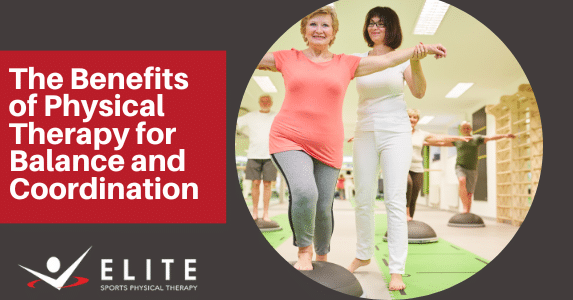Balance and coordination are essential not only for completing everyday activities, like walking, climbing stairs, and getting dressed, but also for injury prevention. If you have difficulty with balance or coordination, you may be at risk of falls and other injuries.
Physical therapy isn’t just for recovery after an injury. Studies show that it can be a prophylactic tool to help avoid serious injury or surgeries in the first place by helping people improve their balance and coordination. Balance is the ability to maintain your body’s position while standing or moving. Coordination is the ability to move your body parts together smoothly and efficiently. Physical therapists have expert “toolbags” full of options to help you strengthen weaknesses and improve your life.
There are many obvious benefits to improving balance and coordination. These include:
- Reduced risk of falls: Falls are a major cause of injury and death, especially in older adults. Improving balance and coordination can help to reduce the risk of falls and keep you mobile and independent for longer.
- Improved mobility: Good balance and coordination can help you to move around more easily and safely with less effort.
- Improved confidence: Feeling more confident in your balance and coordination can help you to participate in more activities and enjoy life fully.
Physical therapists tailor their approach to each patient’s individual needs, considering their underlying condition, age, and functional limitations. This customized and targeted method makes physical therapy a uniquely valuable step in improving imbalances and loss of coordination. Some of the many methods physical therapists may use in their sessions include:
- Targeted Exercises: A cornerstone of physical therapy for balance and coordination enhancement is therapeutic exercises. These exercises specifically target muscle groups, joint stability, and proprioception, which is the ability to sense the position and movement of body parts in relation to one another and the surrounding environment. By incorporating exercises that challenge balance and coordination, patients can enhance their body awareness and control.
- Strengthening Exercises: Strengthening the core muscles, lower body muscles, and postural muscles is crucial for improving balance and coordination. Physical therapists will design a personalized exercise program that focuses on strengthening these key muscle groups, enhancing stability, and promoting proper alignment.
- Balance Training Exercises: Specific balance training exercises challenge the body’s ability to maintain equilibrium while standing or moving. These exercises may include standing on one leg, walking heel-to-toe, or performing tai chi or yoga poses.
- Sensory Enhancement Exercises: Proprioception, the sense of body position and movement, plays a vital role in balance and coordination. Physical therapists may incorporate exercises that enhance proprioception, such as standing on unstable surfaces like foam pads or wobble boards.
- Vestibular Rehabilitation: The vestibular system, located in the inner ear, is responsible for balance control. If the vestibular system is impaired, it can lead to balance problems. Physical therapists can provide vestibular rehabilitation exercises to help the vestibular system adapt and improve balance.
- Gait Training: Gait training focuses on improving walking patterns and efficiency. Physical therapists can assess gait abnormalities and design exercises to correct any imbalances or inefficiencies, leading to a smoother and more stable gait.
- Functional Training: Physical therapists may incorporate functional training exercises that mimic everyday activities, such as reaching, stepping over obstacles, or picking up objects. This helps patients translate their improved balance and coordination into real-world situations.
- Home Exercise Program: Physical therapists will typically provide a personalized home exercise program to help patients maintain their progress and continue improving their balance and coordination outside of physical therapy sessions.
- Fall Prevention Education: Physical therapists can provide education on fall prevention strategies, such as proper footwear, environmental modifications, and fall risk assessment. This knowledge empowers patients to take proactive steps to reduce their fall risk.
- Equipment and Technology: Physical therapists may utilize specialized equipment and technology, such as balance training platforms, virtual reality, or computerized gait analysis, to enhance the effectiveness of balance and coordination training.
If you are concerned about your balance or coordination, talk to your doctor. They may refer you to a physical therapist for an evaluation.
A physical therapist can assess your balance and coordination and develop a treatment plan to help you improve both during the sessions and at home on your own.
With physical therapy, you can improve your balance and coordination and live a safer, more independent life.
If you are looking for a physical therapist in central Texas, call today and make an appointment with Elite Sports Physical Therapy or contact us through our website.
We can help you improve your balance and coordination and achieve your goals.

